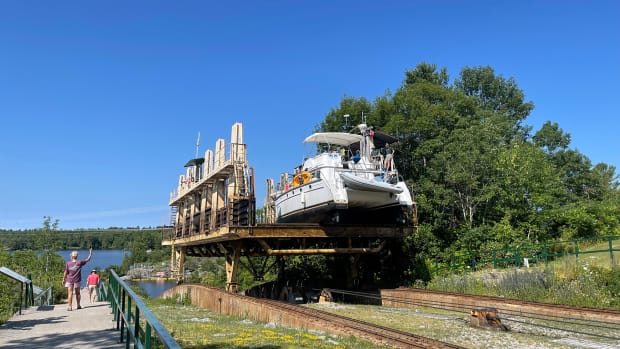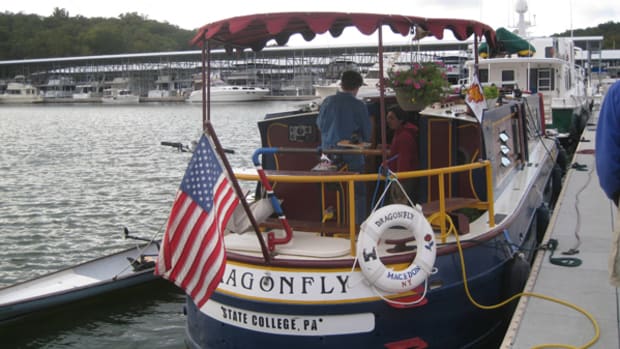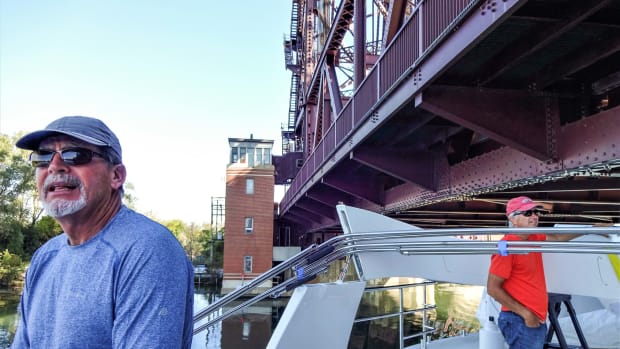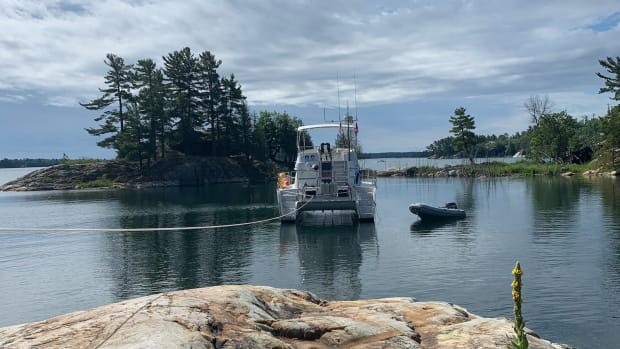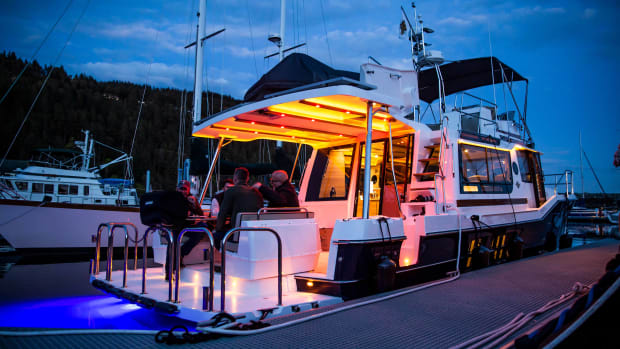Great Circle Loop Information and Resources
HOW FAR IS IT? DISTANCES ON THE GREAT LOOP
Following are some ballpark distances between ports on the Great Loop. We provide these distances for planning purposes only; they don't include going in and out of harbors or anchorages, straying off the path, or making side trips that will rack up many more miles in your log.
Atlantic ICW: Miami, Florida, to Norfolk, Virginia — 1,095nm
Chesapeake Bay: Norfolk, Virginia, to C&D Canal — 185nm
Delaware Bay: C&D Canal to Cape May, New Jersey — 60nm
Atlantic Ocean: Cape May, New Jersey, to Manasquan, New Jersey — 100nm
Atlantic Ocean: Manasquan, New Jersey, to New York, New York — 35nm
Hudson River: New York, New York, to Erie Canal — 155nm
Erie Canal: Waterford, New York, to Three Rivers, New York — 160nm
Oswego Canal: Three Rivers, New York, to Oswego, New York — 25nm
Lake Ontario: Oswego, New York, to Kingston, Ontario — 50nm
Lake Ontario: Kingston, Ontario, to Trenton, Ontario — 60nm
Trent-Severn Waterway: Trenton, Ontario, to Port Severn, Ontario — 240nm
Georgian Bay's Small Craft Route: Port Severn, Ontario, to Killarney, Ontario — 175nm
North Channel: Killarney, Ontario, to Drummond Island, Michigan — 100nm
Lake Huron: Drummond Island, Michigan, to Mackinac Bridge, Michigan — 50nm
Lake Michigan: Mackinac Bridge, Michigan, to Chicago, Illinois — 280nm
Inland river system: Chicago, Illinois, to Mobile, Alabama — 1,250nm
Gulf of Mexico: Mobile Bay to Carrabelle, Florida — 250nm
Gulf of Mexico: Carrabelle, Florida, to Tarpon Springs, Florida — 180nm
Gulf of Mexico: Tarpon Springs, Florida, to San Carlos Bay, Florida — 150nm
Okeechobee Waterway: San Carlos Bay, Florida, to Stuart, Florida — 150nm
HOW LOW IS THAT BRIDGE? WHAT TO KNOW BEFORE YOU GO?
In general, a boat is restricted from making the Great Loop cruise if it draws more than 9 feet or has a vertical clearance higher than 20 feet. That said, our best advice is to have specific measurements of your boat's draft and bridge clearance (including antennas and masts) so you'll be confident you can negotiate some of the low bridges and water along the way. Here are some significant stats on clearances and locks on the Loop:
Atlantic ICW — one lock
Hudson River — one lock
Erie Canal (Waterford, New York, to Three Rivers, New York) — 22 locks; bridge clearance — 20 feet
Oswego Canal — seven locks; bridge clearance — 20 feet
Trent-Severn Waterway — 44 locks; bridge clearance — 22 feet; draft — 5 feet
Illinois Waterway — nine locks
Route 1-Chicago Sanitary and Ship Canal — bridge clearance, 17 feet
Route 2-Calumet-Sag Channel — bridge clearance, 19 feet
Mississippi River — two locks
Ohio River — three locks
Tennessee River — two locks
Tennessee-Tombigbee Waterway — 10 locks
Tombigbee River — two locks
GREAT LOOP CRUISING RESOURCES
What follows is a list of the cruising guides we found most useful when traveling the Great Loop. You'll find these books for sale at marine stores and offered online from their publishers and at www.greatloop.org. These guides list the navigational charts needed for each area, as well. If you're a member of the AGLCA and receive the association's daily email digest, you'll see many used guides and charts for sale by cruisers who have completed the Loop.
Cruising Guide to the Hudson River, Lake Champlain & the St. Lawrence River by Alan and
Susan McKibben
Lake Champlain Publishing Co., 2006
www.lakechamplainpub.com
Cruising the New York Canal System, Cruising the Trent-Severn Canal, Georgian Bay and the North Channel, and Cruising from Chicago to Mobile by Skipper Bob
Waterway Guide Publications
www.waterwayguide.com
Waterway Guide's Great Lakes, Southern, and Atlantic ICW editions
Waterway Guide Publications, 2009 and 2010
www.waterwayguide.com
Guide to Cruising Chesapeake Bay
Chesapeake Bay Communications, 2010
Ports Cruising Guides' The Trent-Severn and Lake Simcoe and Georgian Bay, the North Channel, and Lake Huron
Metroland Media Group, 2009 and 2007
www.portsbooks.com
The Tenn-Tom Nitty-Gritty Cruise Guide by Fred Myers
www.greatloopcruising.com
writerfred@aol.com
The Intracoastal Waterway Chartbook: Miami, Florida, to Mobile, Alabama by John and
Leslie Kettlewell
International Marine, 2008
www.internationalmarine.com
Managing the Waterway: Hampton Roads, VA, to Biscayne Bay, FL by Mark Doyle
Semi-Local Publications, 2009
www.managingthewaterway.com
North America Inland Waterways: Map & Index by David Edwards-May
Euromapping, 2005
www.euromapping.com
STAYING IN TOUCH
On our 5,000-plus-mile Great Loop cruise, we used our VHF radio to talk to towboat skippers, lock tenders, and marina operators, but our VHF also served as our party line with other Loopers. We admit to occasionally listening in on conversations to hear who was going where, where the best price of fuel could be found, which marina had a loaner car, and other useful information.
To stay connected with family, friends, and work through email, we used a wireless broadband card from Verizon for our cell phone and an external antenna. All the major wireless carriers offer such cards. With the exception of Canada, there were very few locations where we couldn't get an Internet connection, even in places where our cell phones didn't work.
The technology is constantly changing, and the broadband cards are getting faster and more reliable. Whatever card you decide to purchase, make sure it can accept an external antenna. If you have more than one computer aboard, the card can swapped between the machines. There are also wireless broadband routers that allow several computers to share the connection.
Visit the website of your wireless carrier and check out the broadband services and equipment they offer. You can also browse the user forums at www.evdoforums.com to learn more about wireless broadband hardware and software.—Katie and Gene Hamilton



